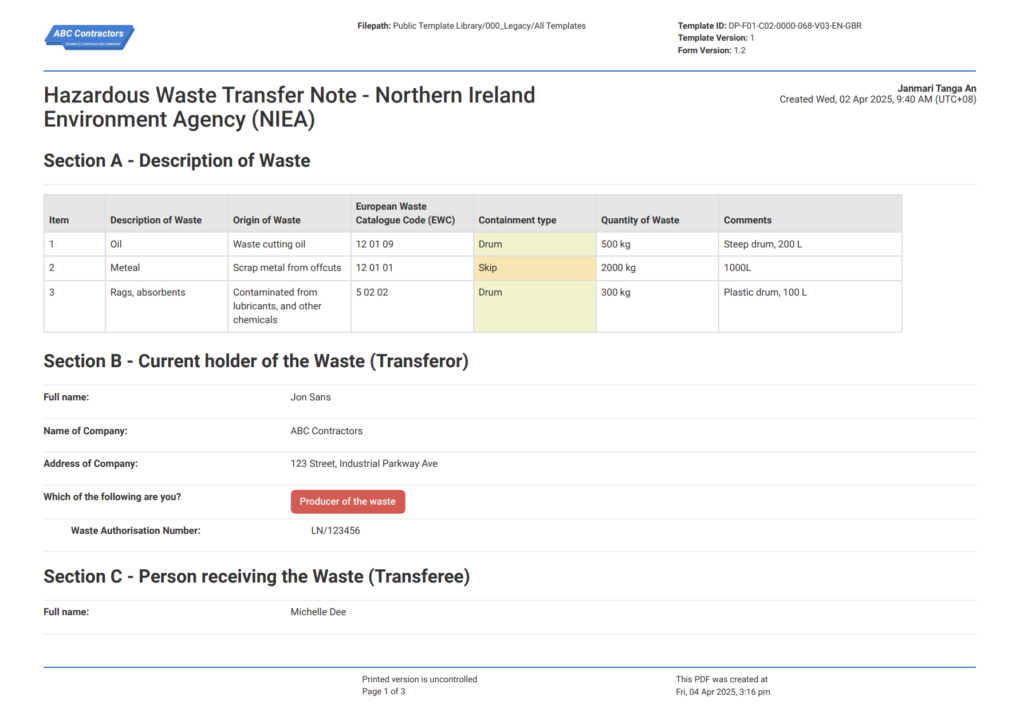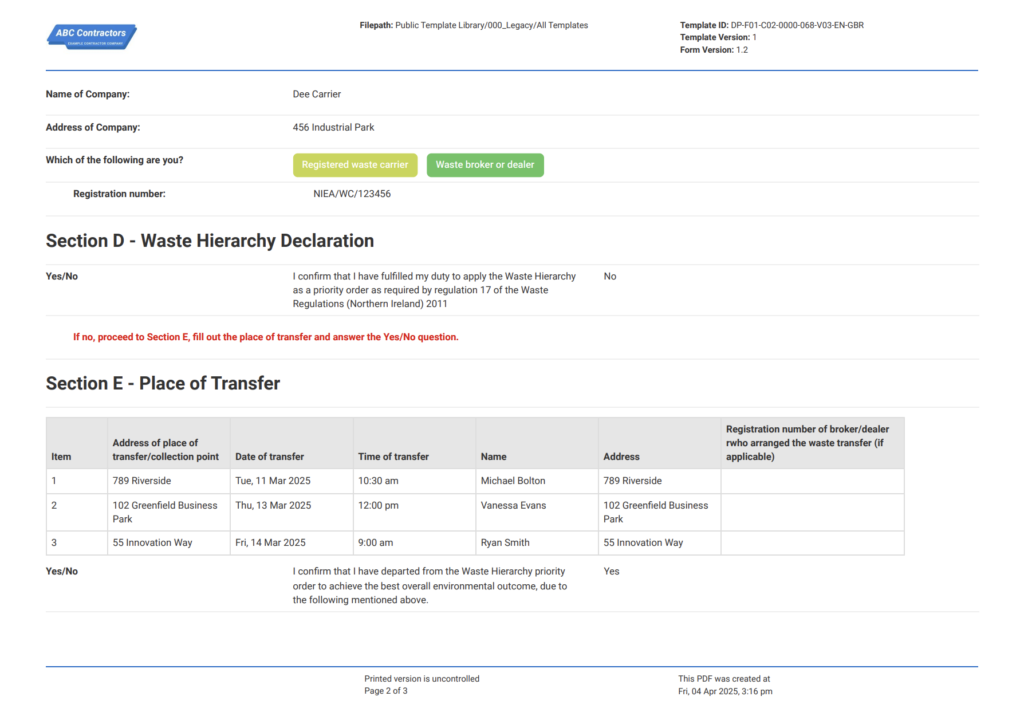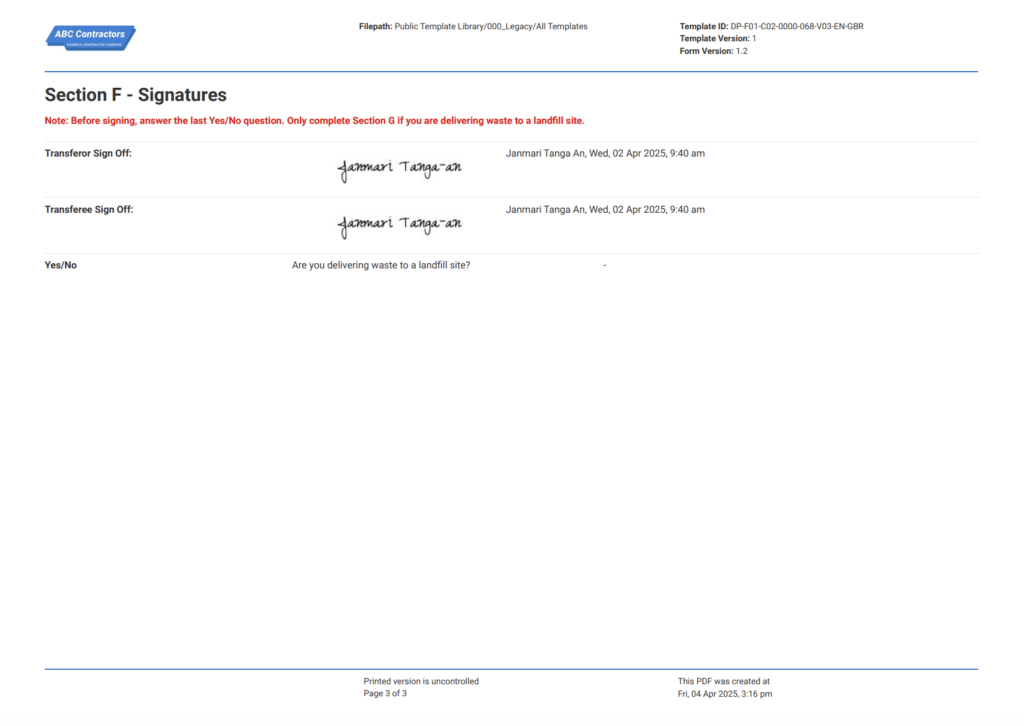Hazardous Waste Transfer Note Template (NIEA)
Start with a free 30-day trial. No credit card required.
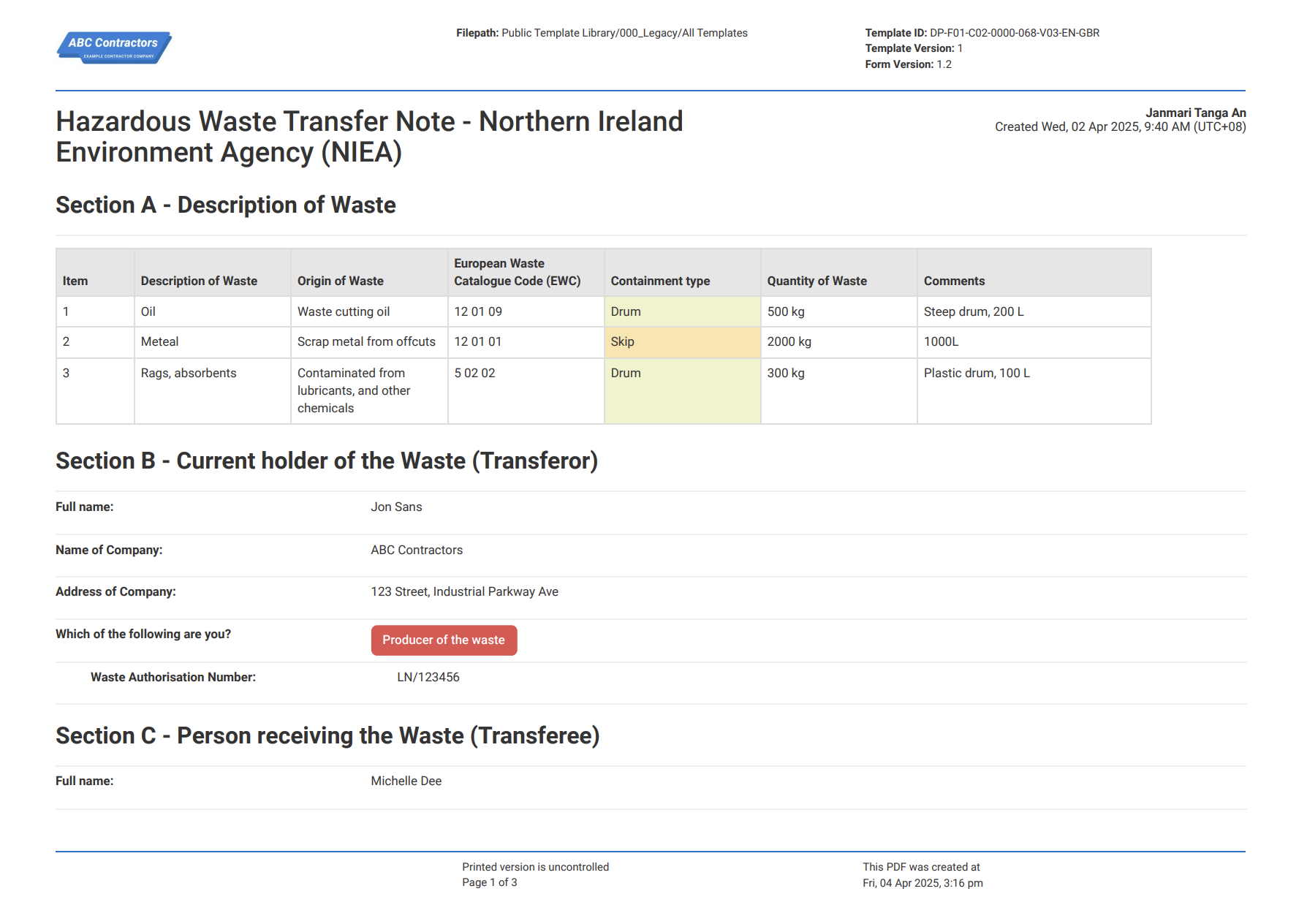
~200 employees
~20 employees
~25,000 employees
~40 employees
~10,000 employees
~1,500 employees
~35,000 employees
What is a Hazardous Waste Transfer Note?
In Northern Ireland, in order to provide documentation of the transfer of hazardous waste from one party to another, you must create a Hazardous Waste Transfer Note. Maintaining the duty of care that businesses have to the environment depends on this very document. All hazardous waste-producing companies in Europe need this document to demonstrate that their waste has been managed appropriately and to make an audit trail that can be retrieved in the event that anything goes wrong during the relocation.
Tracking the movement of waste from its point of origin to its destination is critical, and hazardous waste-producing establishments are obliged by law to keep a Hazardous Waste Transfer Note.
Preview this digital transfer note, compare it to other paper-based forms
Use this Hazardous Waste Transfer Note template for free.
What should a Hazardous Waste Transfer Note contain?
These documents serve as a record that all liable parties involved in the transfer followed strict compliance to regulatory requirements. It is duly important that these documents be coherent, free from errors and contain all necessary data required by regulatory bodies.
Hazardous Waste Transfer Note - Description of Waste
This part of the hazardous waste transfer note details all the important aspects of the waste. It provides information on what kind of waste, where it came from, the code of the waste based on the European Waste Catalogue (EWC), how the waste is contained, the quantity of the waste, and other additional information related to the waste. All of these details are crucial since this is the main basis the auditors will check if the right procedures are done in travelling the hazardous waste.
Current Holder of the Hazardous Waste
This provides information on who is handling the hazardous waste from its origin. The details found here are the name of the person handling the waste, the address of the place where the waste originated, the name of the company producing the waste or handling the waste, and the authorisation number of the producer of the waste or licence of the company handling the waste.
Receiver of Hazardous Waste
This information here presents the information of the person transferring the waste. Most of the required information here is the same as the previous section. It will request to place the name of the person transferring the waste, the address of the company where he belongs , the name of the company that will be handling the waste during travel, and the authorisation number of the producer of the waste or licence of the company handling the waste.
Waste Hierarchy Declaration
To guide and prioritise waste management decisions at the individual and organisational levels, a conceptual framework called the waste management hierarchy is used. In this section, assigned personnel should apply the waste hierarchy as a priority order as required by Regulation 17 of the Waste Regulations (Northern Ireland) 2011.
Place of Transfer
If the waste hierarchy was not applied, the person assigned should fill out this section. This lays out where the waste is going to be transferred. The details found here are the address of the place of transfer, the time and date of transfer, and the name of the person receiving the waste. Additionally, the person assigned should confirm that they have departed from the waste hierarchy priority order to achieve the best overall environmental outcome.
Who Should Sign your Hazardous Waste Transfer Notes?
Transferor
The transferor is the person who is currently holding the hazardous waste at the original location. This assigned person has the responsibility to provide the information required in the first section of the document. He must make sure that all information he provides is factual and true, since this information is crucial for the remaining part of the process. When he has completed his job, he will then be required to sign to verify that he is one hundred percent sure that everything he provided is correct.
Transferee
The transferee is the assigned person who receives the hazardous waste from the original location and handles the waste. His task is to verify the information the transferor has provided and use the waste management hierarchy to handle the waste. If the waste management hierarchy is not applicable, the transferee will then provide the information of the establishment that can handle the waste and confirm that he has departed from the waste hierarchy priority order to achieve the best overall environmental outcome. After this, he will sign to verify that the transferor’s provided information is correct and the procedure for disposal or transfer is provided.
How Does this process help the environment?
In this section, we will help you understand why a hazardous waste transfer note is vitally needed when relocating these hazardous wastes.
Zero possibility of mishandling hazardous waste
Hazardous waste, as you may be aware, is classified as such due to the many adverse impacts it may have on humans, plants, and animals. There are multiple kinds of hazardous waste; therefore, depending on the kind of waste, they must be confined in different methods. A hazardous waste transfer notice is required to ensure that they are contained and loaded appropriately for transfer or disposal.
The HWTN details all the information about the waste to be transferred, which allows the provision of a suitable containment for transporting the hazardous waste to its destination. Additionally, it is part of the process in filling up the HWTN for personnel to review these details before it is allowed to travel. Having all of these done ensures that there is a zero chance of mishandling the hazardous waste.
Legal Compliance to Environmental Regulations
As it was explained above, hazardous wastes have an adverse impact on humans, plants, and animals. This is especially true when it comes to its effect on our environment. There have been multiple times when these hazardous wastes were improperly handled, causing negative irreversible effects on land and water. To make sure that companies follow the correct protocol on handling hazardous waste, regulations were placed.
This was the needed solution in order to continuously protect Mother Earth from these harmful substances. To prove that companies are complying with regulations in transferring waste, the hazardous waste transfer note could serve as evidence. This document entails all the information about the waste, how it was contained, and where it will be transferred. Compiling these can make an auditable trace, which proves the due diligence of the company in their duty to care.
Reputation 100
The consistent practice of making hazardous waste transfer notes prevents companies from ever having to face legal penalties and fines, which greatly affects the reputation of the company. By consistently upholding their duty to care for both people and the environment, companies can maintain a positive reputation.
This can provide a huge advantage in maintaining stakeholder relationships, attracting more partners, ensuring sustainability and success, and boosting employee morale. With this said, all good things come to those companies who are responsible in making sure that the people and the environment are safe and healthy.
Other popular templates you can use and customise for free

EPC Checklist
Get energy performance certificates inline with regulations using this standardised checklist format.

Landfill Checklist template
Use this flexible landfill checklist for your general inspections, landfill safety requirements and more.
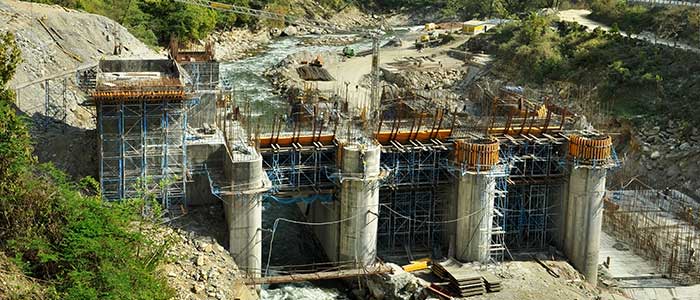
Environmental Risk Assessment
Ensure you have taken the right measures to protect the environment and your team.
This Hazardous Waste Transfer Note was generated with Dashpivot
Free yourselves from the tedious process of making forms from the pen-and-paper method:
- Customise who gets notified when waste is picked up and delivered on specific projects and sites so that everyone is always in the loop and fulfilling their duties.
- Take photos and videos inside of the waste tracking app to add evidence to your documents.
- Set up custom dashboards and charts for the amount of waste being produced or moved, which company has moved the most waste, and more - without doing any manual work.
- streamline and consolidate other environmental, production, safety, quality, and commercial processes.
Sitemate builds best-in-class software tools for built world companies.
